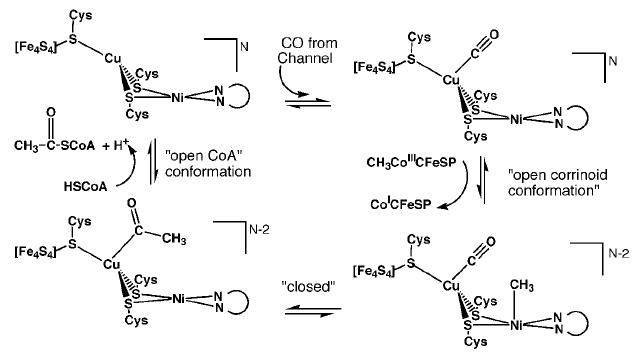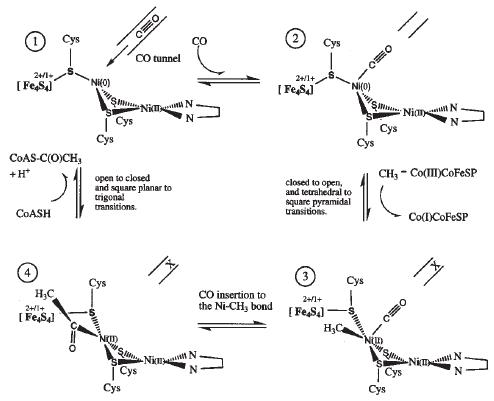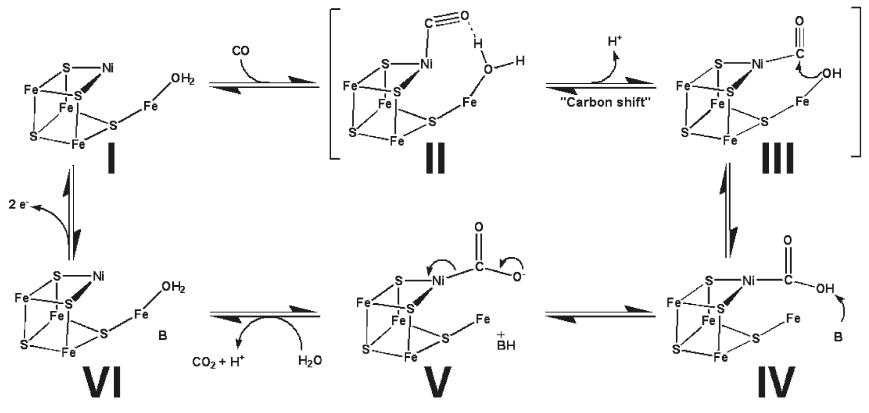Sandbox Reserved 496
From Proteopedia
| Line 9: | Line 9: | ||
=== '''Introduction''' === | === '''Introduction''' === | ||
---- | ---- | ||
| - | Carbon monoxide dehydrogenase/acetyl-CoA synthase (CODH/ACS) is a bifunctional protein which acts as both an oxidoreductase and a transferase by reducing carbon dioxide to carbon monoxide (or the reverse oxidation of carbon monoxide to carbon dioxide) and then catalyzing the synthesis of acetyl-CoA from carbon monoxide, coenzyme A, and the methyl group of an corrinoid iron-sulfur protein. This enzyme plays a key role in the Wood-Ljungdahl pathway which is used by anaerobic, autotrophic bacteria such as ''Moorella thermoacetica'' (f. ''Clostridium thermoaceticum'') and ''Clostridium ljungdahlii'' for gaseous carbon fixation. End products of the Wood-Ljungdahl pathway include cell biomass, acids (ex. acetate and butyrate), and alcohols (ex. ethanol and butanol) – all of which derive from acetyl-CoA. The Wood-Ljungdahl pathway is also the most energetically favorable carbon fixation pathway, but its use is confined to only obligate, anaerobic species <ref name="Berg">PMID:20453874</ref>. Since the discovery of the Wood-Ljungdahl pathway in the early 1980’s, significant effort has been put into trying to characterize the substrate binding activity of CODH/ACS with the ''M. thermoacetica'' protein used as the model in most case studies <ref name="CN">PMID:19583207</ref>. However, little progress was made in defining the exact structure of the protein with crystal structures until the 2000’s. Several reasons why CODH/ACS has received so much attention include the fact that it contains highly disputed metalloclusters, its use of biological organometallic intermediates in reactions, and its contribution to reducing environmental pollutants <ref>PMID: 11841199</ref> <ref>PMID: 11848835</ref>. | + | Carbon monoxide dehydrogenase/acetyl-CoA synthase (CODH/ACS) is a bifunctional protein which acts as both an [http://en.wikipedia.org/wiki/Oxidoreductase oxidoreductase] and a [http://en.wikipedia.org/wiki/Transferase transferase] by reducing carbon dioxide to carbon monoxide (or the reverse oxidation of carbon monoxide to carbon dioxide) and then catalyzing the synthesis of [http://en.wikipedia.org/wiki/Acetyl-CoA acetyl-CoA] from carbon monoxide, coenzyme A, and the methyl group of an corrinoid iron-sulfur protein. This enzyme plays a key role in the Wood-Ljungdahl pathway which is used by anaerobic, [http://en.wikipedia.org/wiki/Autotroph autotrophic] bacteria such as ''Moorella thermoacetica'' (f. ''Clostridium thermoaceticum'') and ''Clostridium ljungdahlii'' for gaseous carbon fixation. End products of the Wood-Ljungdahl pathway include cell biomass, acids (ex. acetate and butyrate), and alcohols (ex. ethanol and butanol) – all of which derive from acetyl-CoA. The Wood-Ljungdahl pathway is also the most energetically favorable carbon fixation pathway, but its use is confined to only obligate, anaerobic species <ref name="Berg">PMID:20453874</ref>. Since the discovery of the Wood-Ljungdahl pathway in the early 1980’s, significant effort has been put into trying to characterize the substrate binding activity of CODH/ACS with the ''M. thermoacetica'' protein used as the model in most case studies <ref name="CN">PMID:19583207</ref>. However, little progress was made in defining the exact structure of the protein with crystal structures until the 2000’s. Several reasons why CODH/ACS has received so much attention include the fact that it contains highly disputed metalloclusters, its use of biological organometallic intermediates in reactions, and its contribution to reducing environmental pollutants <ref>PMID: 11841199</ref> <ref>PMID: 11848835</ref>. |
| Line 26: | Line 26: | ||
| - | The remaining two metalloclusters (both A-clusters) are located in the two α subunits of the CODH/ACS protein. As the active site of ACS activity in each α subunit, the A-clusters are composed of a [Fe4S4] center bridged to a binuclear site. There is some debate regarding the metal ions present in the binuclear site; either both A-clusters are [Fe4S4]-Cu-Ni <ref name="Cu"/> or one A-cluster is [Fe4S4]-Ni-Ni while the other is [Fe4S4]-Zn-Ni <ref name="Zn"/>. The [Fe4S4] center is coordinated by Cys506, Cys509, Cys518, and Cys528 with Cys509 also forming the bridge between the [Fe4S4] and the proximal metal ion. Furthermore, the distal metal ion is coordinated by Cys595, Gly596, and Cys597with Cys595 and Cys597 also connecting the distal and the proximal metal ions. Only the [Fe4S4]-Ni-Ni A-cluster is in an open conformation, the other two site types with Cu or Zn as the proximal ion are in closed form. | + | The remaining two metalloclusters (both A-clusters) are located in the two α subunits of the CODH/ACS protein. As the active site of ACS activity in each α subunit, the A-clusters are composed of a [Fe4S4] center bridged to a binuclear site. There is some debate regarding the metal ions present in the binuclear site; either both A-clusters are [Fe4S4]-Cu-Ni <ref name="Cu"/> or one A-cluster is [Fe4S4]-Ni-Ni while the other is [Fe4S4]-Zn-Ni <ref name="Zn"/>. The [Fe4S4] center is coordinated by Cys506, Cys509, Cys518, and Cys528 with Cys509 also forming the bridge between the [Fe4S4] and the [http://en.wikipedia.org/wiki/Proximal#Proximal_and_distal proximal] metal ion. Furthermore, the distal metal ion is coordinated by Cys595, Gly596, and Cys597with Cys595 and Cys597 also connecting the distal and the proximal metal ions. Only the [Fe4S4]-Ni-Ni A-cluster is in an open conformation, the other two site types with Cu or Zn as the proximal ion are in closed form. |
| Line 68: | Line 68: | ||
==='''Possible Applications'''=== | ==='''Possible Applications'''=== | ||
---- | ---- | ||
| - | Since CODH/ACS consumes CO2 it plays a direct part in the reduction of greenhouse gases by converting CO2 into an intermediate which can transformed into more desirable products such as alcohols and acids. A novel application in which CODH/ACS plays a role is the production of bioethanol from renewable natural resources such wood, grasses, and agricultural residues (ex. corn stover). In this process, the biomass undergoes gasification to yield CO, CO2, and H2. The gases are subsequently fed to bacterial reactor systems containing organisms which utilize the Wood-Ljungdahl pathway and thus produce ethanol. The main goal is to produce a renewable energy source that may be used as an alternative to petroleum. However, at this time, the flux of carbon through the Wood-Ljungdahl pathway does not tend to favor ethanol production so much work remains to be done in this area. On the other hand, the Wood-Ljungdahl pathway does produce significant levels of acetic acid, and to this extent, the pathway is considered a biological equivalent to the Monsanto process for industrial acetic acid production <ref name="Berg"/>. Roughly 10% of the total biological acetic acid production is attributable to anaerobic, autotrophic bacteria which possess CODH/ACS enzymes. | + | Since CODH/ACS consumes CO2 it plays a direct part in the reduction of greenhouse gases by converting CO2 into an intermediate which can transformed into more desirable products such as alcohols and acids. A novel application in which CODH/ACS plays a role is the production of bioethanol from renewable natural resources such wood, grasses, and agricultural residues (ex. corn stover). In this process, the biomass undergoes [http://en.wikipedia.org/wiki/Gasification gasification] to yield CO, CO2, and H2. The gases are subsequently fed to bacterial reactor systems containing organisms which utilize the Wood-Ljungdahl pathway and thus produce ethanol. The main goal is to produce a renewable energy source that may be used as an alternative to petroleum. However, at this time, the flux of carbon through the Wood-Ljungdahl pathway does not tend to favor ethanol production so much work remains to be done in this area. On the other hand, the Wood-Ljungdahl pathway does produce significant levels of acetic acid, and to this extent, the pathway is considered a biological equivalent to the [http://en.wikipedia.org/wiki/Monsanto_process Monsanto process] for industrial acetic acid production <ref name="Berg"/>. Roughly 10% of the total biological acetic acid production is attributable to anaerobic, autotrophic bacteria which possess CODH/ACS enzymes. |
==='''References'''=== | ==='''References'''=== | ||
Revision as of 17:09, 2 May 2012
|Bold text
| This Sandbox is Reserved from 13/03/2012, through 01/06/2012 for use in the course "Proteins and Molecular Mechanisms" taught by Robert B. Rose at the North Carolina State University, Raleigh, NC USA. This reservation includes Sandbox Reserved 451 through Sandbox Reserved 500. | |||||||
To get started:
More help: Help:Editing For more help, look at this link: http://www.proteopedia.org/wiki/index.php/Help:Getting_Started_in_Proteopedia
Bifunctional Carbon Monoxide Dehydrogenase/Acetyl-CoA Synthase (CODH/ACS)
IntroductionCarbon monoxide dehydrogenase/acetyl-CoA synthase (CODH/ACS) is a bifunctional protein which acts as both an oxidoreductase and a transferase by reducing carbon dioxide to carbon monoxide (or the reverse oxidation of carbon monoxide to carbon dioxide) and then catalyzing the synthesis of acetyl-CoA from carbon monoxide, coenzyme A, and the methyl group of an corrinoid iron-sulfur protein. This enzyme plays a key role in the Wood-Ljungdahl pathway which is used by anaerobic, autotrophic bacteria such as Moorella thermoacetica (f. Clostridium thermoaceticum) and Clostridium ljungdahlii for gaseous carbon fixation. End products of the Wood-Ljungdahl pathway include cell biomass, acids (ex. acetate and butyrate), and alcohols (ex. ethanol and butanol) – all of which derive from acetyl-CoA. The Wood-Ljungdahl pathway is also the most energetically favorable carbon fixation pathway, but its use is confined to only obligate, anaerobic species [1]. Since the discovery of the Wood-Ljungdahl pathway in the early 1980’s, significant effort has been put into trying to characterize the substrate binding activity of CODH/ACS with the M. thermoacetica protein used as the model in most case studies [2]. However, little progress was made in defining the exact structure of the protein with crystal structures until the 2000’s. Several reasons why CODH/ACS has received so much attention include the fact that it contains highly disputed metalloclusters, its use of biological organometallic intermediates in reactions, and its contribution to reducing environmental pollutants [3] [4].
StructureThe CODH/ACS enzyme from M. thermoacetica is an α2β2 tetramer with seven metalloclusters. Each 674 residue β subunit carries out CODH activity, while each 729 residue α subunit is responsible for ACS activity. From the N- terminus to C-terminus, the domains of the β subunit are as follows: an α-helical domain (residues 1-257) followed by two α/β Rossmann-like domains (residues 262-458 and 463-674). The β subunit has 57% helical and 9% β-sheet character with 31 helices and 15 β-strands. The α subunit is also comprised of three domains, two with α+β folds and a third with a helical region (residues 1-154) at the N-terminus of a Rossmann (six-stranded α/β) fold (residues 155-316) which is similar to a portion of the β subunit structure [5] [12]. Overall, the α subunit has 50% helical and 14% β-sheet character with 36 helices and 22 β-strands.
Mechanism of Actionβ subunit reactions C-cluster (CODH activity): CO2 + 2H+ + 2e- ↔ CO + H2O B- and D-clusters: electron transfer
A-cluster (ACS activity): CH3-Co(III)-CFeSP + CO + HSCoA ↔ CH3-CO-SCoA + Co(I)-CFeSP + H+
 Proposed mechanism 1 for ACS activity with Cu-Ni ions in the binuclear site of the A-cluster. [5]
 Proposed mechanism 2 for ACS activity with Ni-Ni ions in the binuclear site of the A-cluster. [13]
 Proposed mechanism for CODH activity in the C-cluster. [2] Possible ApplicationsSince CODH/ACS consumes CO2 it plays a direct part in the reduction of greenhouse gases by converting CO2 into an intermediate which can transformed into more desirable products such as alcohols and acids. A novel application in which CODH/ACS plays a role is the production of bioethanol from renewable natural resources such wood, grasses, and agricultural residues (ex. corn stover). In this process, the biomass undergoes gasification to yield CO, CO2, and H2. The gases are subsequently fed to bacterial reactor systems containing organisms which utilize the Wood-Ljungdahl pathway and thus produce ethanol. The main goal is to produce a renewable energy source that may be used as an alternative to petroleum. However, at this time, the flux of carbon through the Wood-Ljungdahl pathway does not tend to favor ethanol production so much work remains to be done in this area. On the other hand, the Wood-Ljungdahl pathway does produce significant levels of acetic acid, and to this extent, the pathway is considered a biological equivalent to the Monsanto process for industrial acetic acid production [1]. Roughly 10% of the total biological acetic acid production is attributable to anaerobic, autotrophic bacteria which possess CODH/ACS enzymes. References
|
